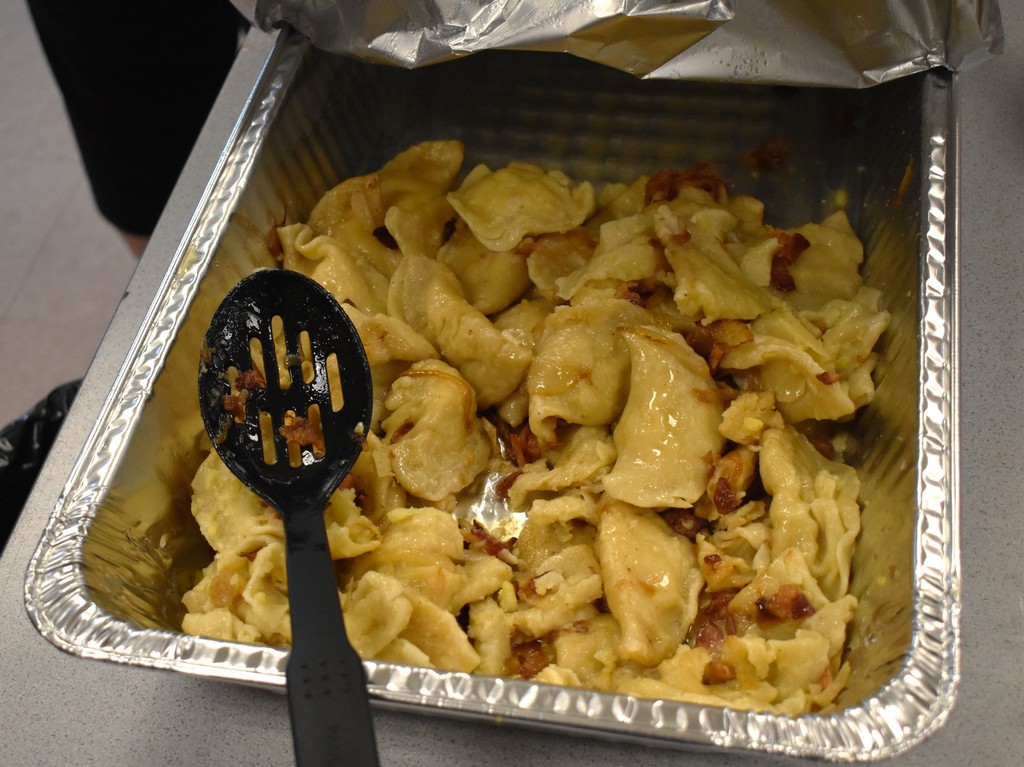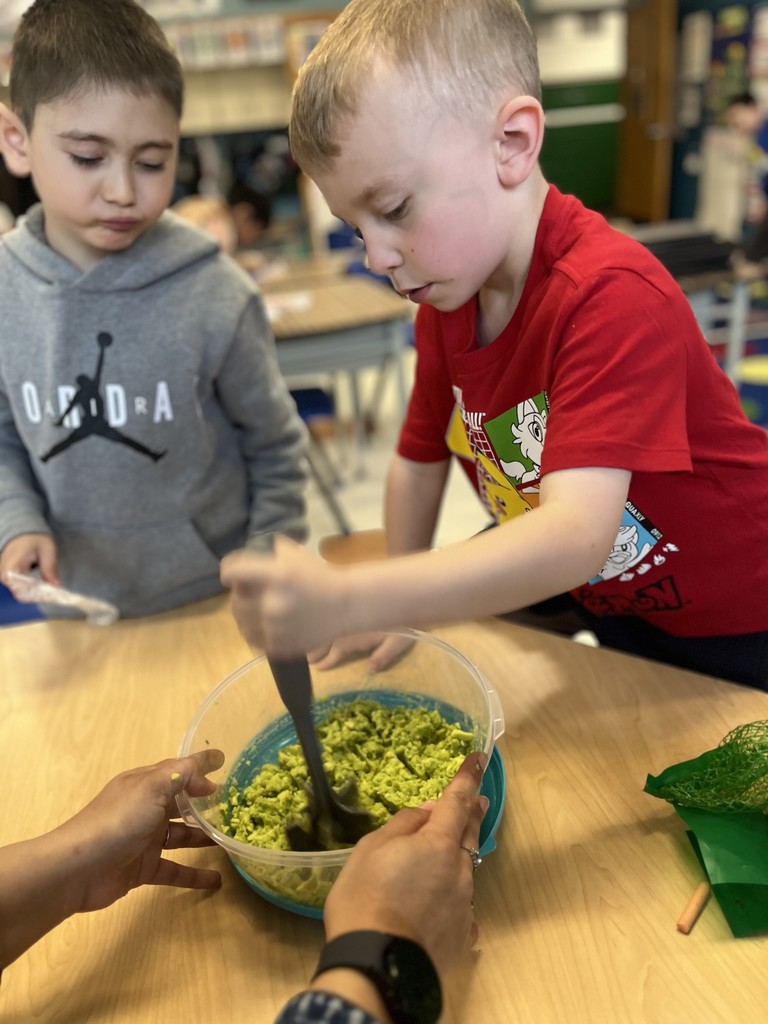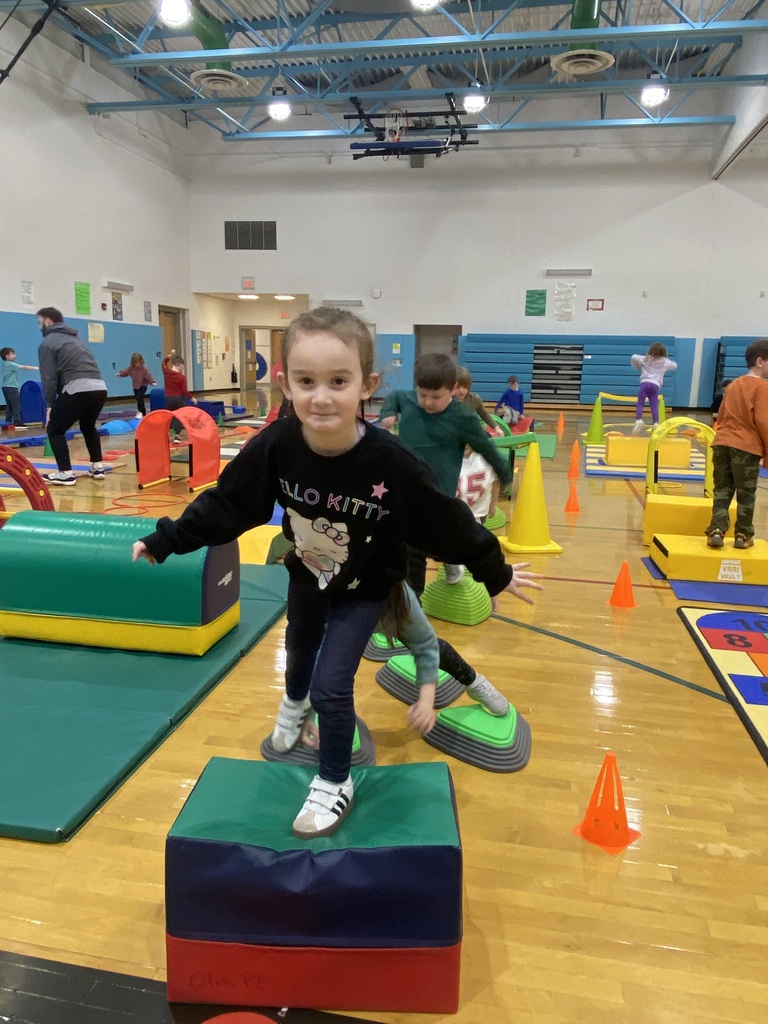Rose Marie Cricchios’ High School “Speaking for Success” class recently completed a class project called “The Competitive Container Corporation.”
In this activity, the class was divided into groups to form small corporations that would develop a new container product. Each corporation’s task was to design and build “the world’s best container” made of paper. They had one class period to construct their best container using only designated materials. Each container was judged on its capacity, aesthetics, sturdiness and sales pitch.
Preparing their “sales pitch” allowed the groups to further practice and refine communicating in groups and working under time pressure while capitalizing on discovered individual talents. It was a great lesson which has real world applications!



When the weather cooperates, Physical Education teacher Leyla Johnson has been taking her intermediate and elementary students to the high school track to introduce them to track & field events. Take a peek at her IS fourth-graders, who recently were introduced to the long jump!
In track & field, the long jump is a field event where athletes aim to jump as far as possible from a designated takeoff point (a board) into a sandpit. Athletes run along a runway, gathers speed, and then jumps, with the distance measured from the edge of the board to the closest point of body contact in the sandpit.




Mother's Day is Sunday; Happy Mother's Day to all our school community's mothers, important mother figures, grandmothers and the "special someones" who play critically important roles in the lives of our students!
Thanks to the generosity of the Otisville PTO, all K-5 students are making special gifts for the special people in their lives today! (Don't look if you're one of them...or act surprised when the gift is presented to you!)







Is there connection between cookies, cake, frosting, cupcakes, candy and baking decorations and cell production? There absolutely is…. just ask Kimberly Jordan’s Freshman Biology students!
Mrs. Jordan's Freshman Biology students recently had some hands-on creative fun in a unique cell biology lab! They built body cells and sex cells using their favorite foods, making learning about cell production --- specifically mitosis and meiosis --- a tasty and sweet experience! Best of all, everything was edible! (Everything was devoured, by the way). Take a look --- each piece is unique, creative and colorful!
Mitosis and meiosis are two types of cell division, but they serve different purposes and have distinct outcomes. Mitosis is a process that results in two identical daughter cells, each with the same number of chromosomes as the parent cell, and is crucial for growth and repair in the body. Meiosis, on the other hand, produces four unique gametes (sperm and egg cells) with half the number of chromosomes as the parent cell, a process essential for sexual reproduction and genetic diversity.










What’s cookin’ in Victoria Ingrassia’s Middle School kitchen?
Eighth-grade FACS students have made pierogi! Take a peek at their preparation, cooking and “eating” time over these last few days, which also included sauteed onions, bacon and sour cream! Many members of the Middle School faculty stopped by for a very delicious snack!
•Pierogi, a beloved Polish dumpling, have a complex and somewhat disputed history. While commonly associated with Poland, the dish's origins may have roots in Central Asia, with some tracing them back to China via Marco Polo's travels. Regardless of their exact origins, pierogi have a rich history in Poland, dating back to at least the 13th century.
•While the exact origin is unclear, a popular story attributes the introduction of pierogi to Poland to Saint Hyacinth, a Polish saint who is said to have brought them from Ukraine in the 1200s.
•Boiling pierogi is the most popular method of cooking pierogi because it adds no additional calories to your meal. It also offers a soft, delicate texture which is the more traditional way of eating Polish pierogi.
•The word pierogi comes from the Slavic word, "pir," meaning “festivity.” This makes sense as pierogi are often associated with, and served during the holidays, also making them a comfort food for many.









Meghan Donohue’s ES first graders, like other district first-graders, have been learning about the difference between living and non-living things.
They know that living things move, change and grow…and even if they can’t see it in “real time,” plants are constantly moving, changing & growing, just like they are!
Students have also learned about the life cycle of plants, and what’s needed for them to survive. They put their knowledge to work by starting a class garden! Students followed a sequence of steps to ensure their planting process was perfect and are looking forward to seeing their flowers bloom soon!
Like their peers in other ES first-grade classes, students also have some new “class pets”: LADYBUGS!
Classrooms are now homes to a growing population of ladybug larvae. Students continue to observe them in the early stages of life, and are anxiously awaiting the next stage in the ladybug life cycle. Thus far, students have observed their baby bugs in the larva stage, their second stage of life. Next up will be the pupa stage, followed by emerging ladybugs!








What do fireworks, cake and a winter tablecloth mean? There’s only one correct answer: The 2025 edition of Vale, the high school yearbook, is complete and off for printing!
Kool and the Gang’s “Celebration” blasted from Room 126 as the final pages were submitted. Editor-in-chief Aislyn Struble completed the final submission and then read her theme opening to “Out Loud!” to her yearbook staff peers!
Did you know that staff operates as a high school art elective class and is taught by Kat Hoolan and copy advised by Laura Lalor?
But, why the winter tablecloth, you may ask. That’s because the staff only has one for deadline celebrations, and it’s become part of the staff traditions no matter the season. Yearbooks will arrive in early June!





SEEING ‘EARTH SCIENCE’ IN PERSON!
Anthony Muccari’s, Vincent Napolitano’s and Toni McGinn’s High School’s Earth Science classes took learning to the next level with their recent amazing, outdoor classroom experience to Sam’s Point at Lake Minnewaska State Park! Park staff led the group to breathtaking views and gave hands-on lessons about the unique geology of the Shawangunk Ridge.
Sam's Point is a 5,000-acre preserve within Minnewaska State Park Preserve, located in the southern Shawangunk Mountains in Ulster County It's known for its unique high-altitude pitch pine barrens, which are home to a variety of rare and common flora and fauna. Sam's Point also features scenic vistas, waterfalls, ice caves, and the "sky lake" Lake Maratanza.
PLUS: Thanks to the “Connect Kids to Parks” grant from New York State, the entire trip was completely free for students!
Sam’s Point is home to one of the few remaining dwarf pitch pine barrens in the world, growing on ancient quartz conglomerate rock that’s over 400 million years old!








MARK YOUR CALENDARS NOW!
One of the biggest district-wide events will take place Tuesday, May 20: The annual annual District Art Show/K-12 Exhibition! Over 400 student artists representing the High School, Middle School, Otisville Elementary the Intermediate School and the Elementary School will have work on display from 5 to 8 p.m. at the High School cafeteria and auditorium. It's always a gorgeous and vibrantly colorful exhibition, featured all kinds of art mediums! This exhibition is equally wonderful because of the smiles on the proud families and students! Please join us!

BRAVO!
Plays are meant to be seen and experienced and there’s many times when students assume roles of characters and read the play out loud! Take a look at Jenn Thibodeau’s and Catina Brooks’ High School English 10 students, who recently read Lorraine Hansberry’s “A Raisin in the Sun” out loud in class.
This play that explores the struggles of the Younger family, an African-American family in Chicago, as they navigate financial hardship, racial prejudice, and the pursuit of the American Dream after the death of the patriarch, “Big Walter.” The play examines their conflicting dreams and aspirations, and the impact of their choices on their family's future.
"A Raisin in the Sun" is often read in English classes to explore themes of race, class, family, and the "American Dream." By studying this play, students can further develop critical thinking skills, analyze complex characters, and examine how social and historical contexts shape individual lives.
“This is a powerful play that relates to kids and the financial struggles that many families can face and realizing what is really important in life,” said Ms. Brooks. “The kids enjoyed the play and reading the characters of the excitable and frustrated Walter, the powerful matriarch Mama, the intellectual Beneatha, and other memorable characters. Having them actively engaged with the characters keeps them focused and leads to understanding motivation and having deeper comprehension. It’s a fun and memorable experience.”
The play debuted on Broadway in 1959. The New York Drama Critics' Circle named it 1959’s best play, and in recent years publications such as The Independent[t] and Time Out have listed it among the best plays ever written.










Congratulations to the 17 students who were recognized at the NYSAHPERD Catskill Zone Leadership Awards Ceremony, held this past Saturday at Wallkill High School!
This event honors top-grade-level students who exemplify excellence in fitness, leadership, and citizenship—key components of New York State learning standards.
These students were selected for their commitment to an active lifestyle, responsible behavior, leadership qualities, and contributions to their school community. While athletic ability is not a requirement, each honoree embodies the spirit of personal growth and positive influence.
"These students are role models who lead by example, showing us the power of character, effort, and service in physical education and beyond,” said Physical Education teacher Theresa Uhelsky, the organization’s past president.
Students honored were:
Middle School
• Mason King
• Ben Ziegler
• Lennox Addo
• Erin Arias
• Lyla LeBarbera
Otisville Elementary
• Leah Galligan
• Quinn Lattimer
• Luca Artola
• Eliya Graziano
Intermediate School
• Ella Manzie
• Madison Worden
• Jemma Marsala
• Charlotte Kohler
Elementary School
• James Santos
• Gary Boyajian
• Declan Barry
• Kaylee Jackler





¡Buenos días! Meghan Donahue’s ES first-graders spent some time yesterday learning about Cinco de Mayo and afterward, had the very cool opportunity to help prepare fresh guacamole!
In addition to learning about Cinco de Mayo, students learned that an avocado is a fruit! Botanically, it's classified as a single-seeded berry. While it's often used in savory dishes and considered a vegetable in some culinary contexts, its development from the ovary of a flowering plant and the presence of a seed make it a fruit.
Students used their five senses to describe avocados on the outside and inside, including tasting them! After exploring avocados, students followed a sequence of steps and directions and learned about authentic Mexican ingredients to make the perfect guacamole for their Cinco de Mayo treat! What a great history, science, culinary and multi-step direction lesson!
•Cinco de Mayo, which means "Fifth of May" in Spanish, is a holiday celebrating the Mexican army's victory over the French at the Battle of Puebla on May 5, 1862. While it's often mistaken for Mexican Independence Day, it's actually a celebration of Mexican pride and the courage of the Mexican army.
•In Mexico, Cinco de Mayo is more of a regional celebration, especially in the state of Puebla, where the battle took place. Celebrations are also seen in other Mexican regions, like the Peñon de los Baños neighborhood of Mexico City. However, it's not a national holiday, and most businesses are open.
•In the United States, Cinco de Mayo has evolved into a more widespread celebration of Mexican culture, with parades, festivals, and celebrations featuring Mexican music, food, and traditions.
•The main ingredient in guacamole is avocado, which is mashed and then mixed with other ingredients like lime juice, salt, and sometimes cilantro, onion, and jalapenos. While the avocado is the core component, other flavors like onion, tomato, garlic, and spices like cumin can be added for a more complex flavor profile.








MORE BOWLING FUN!
Anthony Pascarelli’s ES physical education kindergarteners are having a blast learning about bowling!
They understand what a “strike” and “spare” means and are learning proper bowling form in class! Take a peek!
Bowling offers numerous benefits for kindergarteners, fostering physical, mental, and social development. It improves hand-eye coordination, balance, and strength, while also developing focus, patience, and social skills like teamwork and sportsmanship. Bowling also subtly builds analytical skills through calculating scores and understanding angles.






Physical education teachers Stephanie Giufre and Tom Uhrig a recent SUPER FUN and colorful obstacle course for their K-1 students! Take a peek at these cuties and ask them about it!
There are so many learning opportunities for these young students to gain besides the thrill of course completion! This obstacle course helps them to better understand concepts like “in,” “out,” “over,” “ under,” “around,” “through,” “up” and “down.”
PLUS...the course also promotes overall physical fitness, gross motor development (using large muscles), bilateral coordination (using both sides of the body at the same time), perceptual motor development (receive, interpret and respond to sensory information), agility, coordination, spatial awareness, listening skills and balance.










We’re always grateful when our community education colleagues visit the High School to meet with students. THANK YOU to Javon Joslyn of SUNY Orange, who met with interested juniors and seniors yesterday, May 1, about SUNY Orange’s Plus Programs. These programs provide training for a variety of rewarding careers, including culinary arts, CDL training, certified clinical medical assistants, home health aides, security guards and more! Ms. Joslyn’s presented focused on the Work Force Development and FoodTec programs. To learn more, visit: https://sunyorange.edu/plus/



To embrace the flourishing spring season, students in Jonathan Bond’s “Mindful Self Design” class and Chris Ruckdeschel’s “SUPA Psychology” class recently took a field trip to the Pocono Environmental Education Center (PEEC) in the Delaware Water Gap National Recreation Area.
The trip provided a perfect blend of outdoor adventure and personal growth, with a focus on team-building and individual challenges. Students were quickly immersed in a series of team-building exercises designed to foster confidence, trust, and communication. They participated in numerous small rope courses in which their classmates were their “spotters.” There were also several problem-solving activities that required students to act in a thoughtful manner, provide support, and implement teamwork. Students “snow-shoed” with wooden planks, carefully weaved themselves through a web, and even acted as beavers in a dam to get over a wall.
These exercises not only broke the ice, but laid a foundation for further connection and team building among students! What a great and creative field trip idea!




Theresa Uhelsky’s High School Adapted Physical Education classes recently wrapped up a fun and skill-building bowling unit in the gym --- then took those skills to the next level with a real-life trip to Pinstreet Bowling Alley in Warwick!
Students learned how to select the right bowling ball, set up scoring, and use effective techniques to improve their game. With support from our amazing chaperones --- Christine Ertola, Christina Faline, and Tim Bult, students had the chance to put their skills into action and enjoy some friendly competition.
THANK YOU to Pinstreet for welcoming our students and generously providing each of them with passes for two free games. What a wonderful way to connect classroom learning with real-world fun!








If it's Spring, it means the Intermediate School's Bike Club is back on the road!
Run by advisors Physical Education teacher Theresa Uhelsky and Security Officer Kevin Murphy, groups meet on Wednesdays and Fridays to learn how to become more proficient in bike riding. This includes important safety rules, too. And, everyone has a fun time!






Kudos to High School students Zoe Schultz, Morgan Varian, Zuri Poinsette, Erin Huggins-Williams (and her mom Cindy), Gia Gangi, Baylie Touw and Cheyann Kumar for their volunteer assistance at last Saturday’s “Hike for Hope,” at Bear Mountain State Park, an event organized by the American Foundation for Suicide Prevention. They ran the arts and crafts tables and healing activities to over 500 participants. We always love it when our students give back and help others! THANK YOU and WELL-DONE!







Megan St Clair’s and Sarah Kocot’s ES second-graders, like all district second-graders, have been learning about the human body and many of its organs. In this recent and amazing lesson, students first worked with a miniature skeleton to place the organs they were learning about in the correct position.
Later, their teachers incorporated a fun art component to this science lesson by creating student-sized body outlines! In five different groups, students took what they learned on the smaller skeleton and correctly placed organs on the outlined body, labeling each organ. Each “body” was distinctively unique, with each group’s creativity giving their “body” its own personality!
Plus, a byproduct of this lesson was students had the opportunity to work in groups! Group work allows them to learn to share ideas, listen to others, and work collaboratively, which are valuable skills for both school and real-life situations. It also encourages critical thinking and problem-solving as they discuss and evaluate information together.










